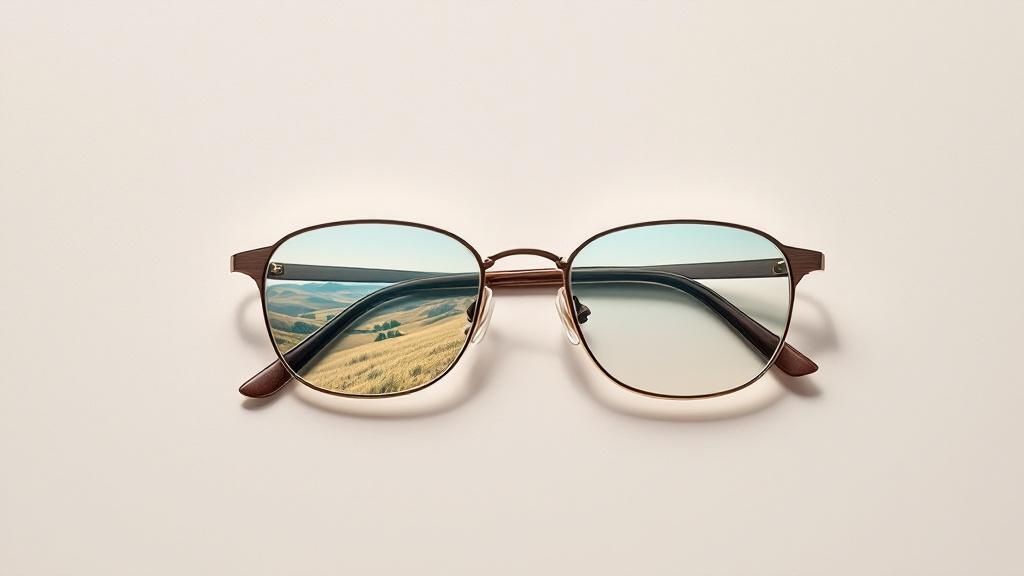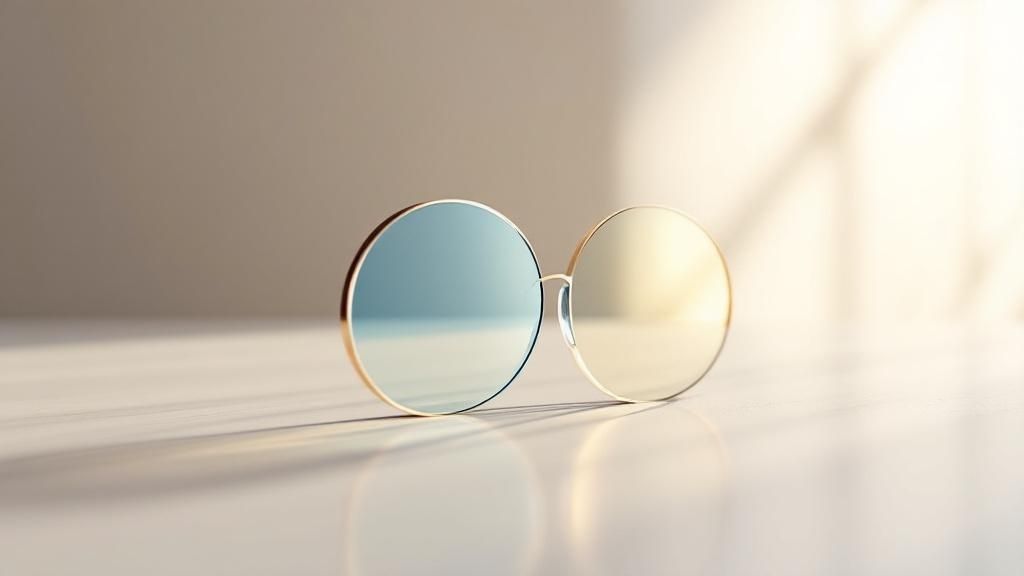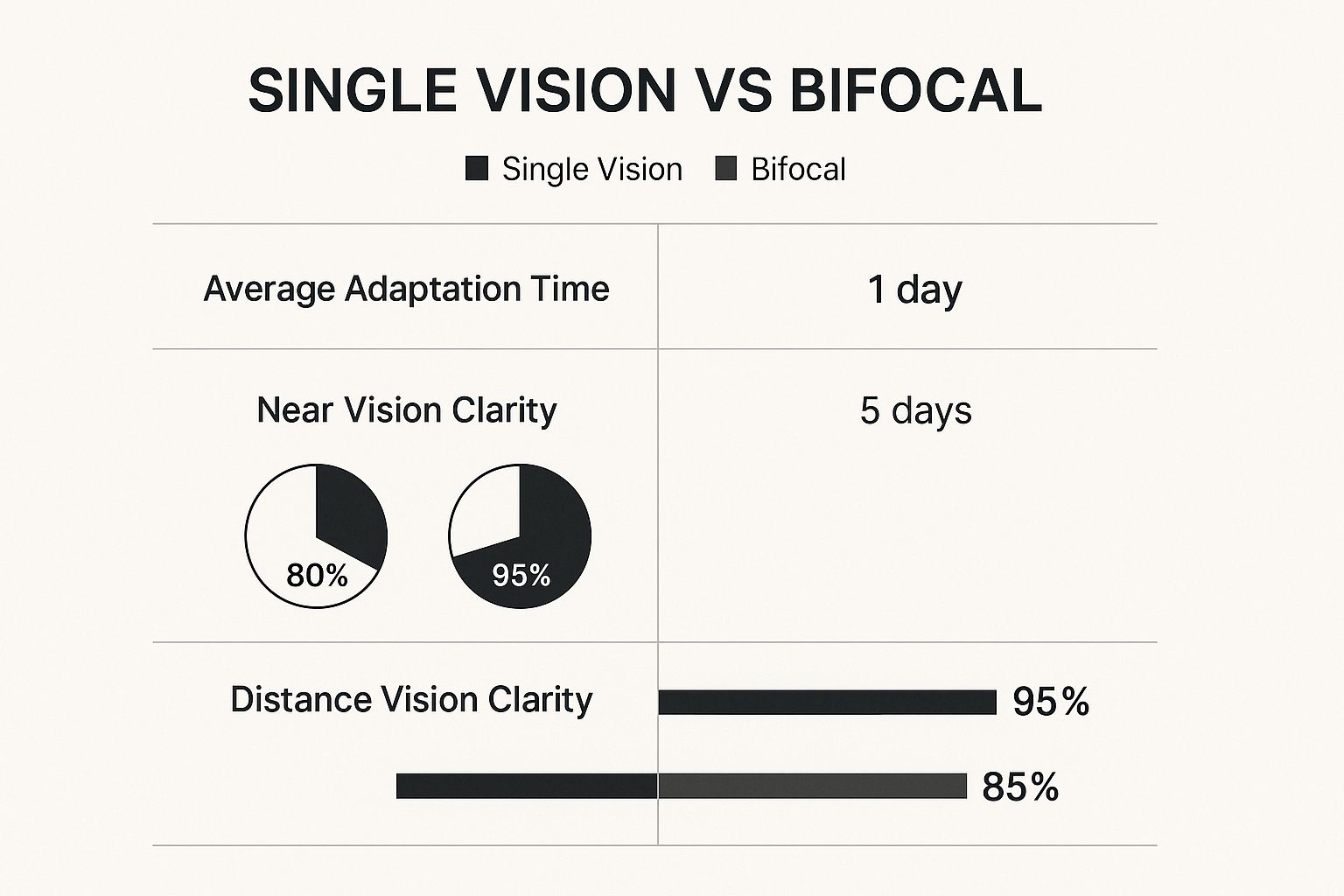
Single Vision vs Bifocal Lenses Which is Best?
The core difference between single vision vs bifocal lenses boils down to a simple question: do you need to correct your vision at one distance, or two? Single vision lenses are built for one job—fixing sight either up close or far away. Bifocals, on the other hand, pack two different prescriptions into a single lens to handle both.
Your choice really depends on whether your vision challenges are singular or a bit more complex.
Your First Look at Lens Options
Think of your glasses prescription as a roadmap to seeing clearly. The first big decision on that journey is picking the right lens type. This choice is fundamental, shaping how you see everything from the road ahead to the book in your hands or the screen on your desk.
Single vision lenses are the go-to for most people. They have one consistent prescription strength across the entire surface. This straightforward design is perfect for tackling specific, common vision issues like:
- Myopia (Nearsightedness): When distant objects look fuzzy.
- Hyperopia (Farsightedness): When it's tough to focus on things up close.
- Astigmatism: A condition caused by an irregular eye shape that creates blurriness at any distance.
In contrast, bifocals are a clever solution for a dual-distance problem called presbyopia. This is the natural, age-related change that makes focusing on near objects a struggle, and it’s why so many of us over 40 find ourselves reaching for reading glasses. Bifocals tackle this by placing your distance prescription in the upper part of the lens and adding a distinct segment at the bottom for your near vision.
At a Glance: Single Vision vs. Bifocals
To make it even simpler, here’s a quick breakdown of who each lens is best for.
| Lens Type | Primary Function | Ideal For |
|---|---|---|
| Single Vision | Corrects for a single, uniform field of vision. | Individuals with myopia or hyperopia; dedicated task glasses (e.g., for reading or computer use). |
| Bifocals | Combines two prescriptions for both near and distance vision. | Individuals with presbyopia who need correction for both far-away and up-close tasks simultaneously. |
This table gets to the heart of the matter, helping you quickly identify which path might be right for you.
The market definitely shows how common single-distance vision problems are. In 2023, single vision lenses made up the largest piece of the global prescription lens market, grabbing a share of about 27.1%. This is no surprise, given how widespread myopia has become globally.
Knowing these basics is a great start. But technology has come a long way, and you can dive much deeper by exploring the full range of lens options for glasses to see how different materials and coatings can further enhance your vision.
The Complete Guide to Single Vision Lenses
 Single vision lenses are the workhorses of the eyewear world. They're the most common type of prescription lens, and for good reason—they have one job, and they do it perfectly. Their entire surface has a single, uniform power designed to correct your vision at one specific distance.
Single vision lenses are the workhorses of the eyewear world. They're the most common type of prescription lens, and for good reason—they have one job, and they do it perfectly. Their entire surface has a single, uniform power designed to correct your vision at one specific distance.
What this means for you is a wide, consistent field of view without any of the distortions or visual speed bumps you might find in other lenses. They're the go-to solution for straightforward refractive errors. If you're struggling with myopia (nearsightedness) and can't quite make out distant road signs, or if you have hyperopia (farsightedness) and need help seeing things up close, single vision lenses are engineered for that exact task.
How Single Vision Corrects Your Focus
The real magic is in the lens's shape. These lenses work by precisely bending light before it hits your eye, making up for the way your eye focuses incorrectly. Think of it as giving the light a little nudge in the right direction.
- For Myopia: A concave lens is the tool for the job. It's thinner in the middle and thicker at the edges, which spreads the light rays out and moves your eye’s focal point backward, landing it squarely on the retina.
- For Hyperopia: Here, a convex lens is needed. This one is thicker in the center and thinner at the edges, bringing the light rays together to move the focal point forward onto the retina.
This focused approach delivers edge-to-edge clarity, which is a huge plus for activities that demand a broad and stable field of view, like driving or settling in for a movie. There's no need to tilt your head to find the "sweet spot" because, with single vision, the entire lens is the sweet spot.
Key Insight: The biggest advantage of single vision lenses is their uninterrupted visual field. Unlike multifocal options, they provide consistent clarity from every angle, which is why they are so often preferred for dedicated, single-distance tasks.
Understanding Lens Materials and Their Impact
The material your lenses are made from is just as crucial as the prescription itself. Different materials will impact the weight, thickness, and overall durability of your glasses. For those of us with stronger prescriptions, high-index plastics are a total game-changer, as they bend light more efficiently to create lenses that are significantly thinner and lighter.
This isn't a niche market, either. The global single-vision lenses market was valued at around USD 7.2 billion in 2022 and is on track to hit approximately USD 9.5 billion by 2030. Within this market, materials like polycarbonate are leading the charge because they're incredibly lightweight and impact-resistant—perfect for the rigors of daily wear. You can discover more about these market insights on Zion Market Research and see what's driving these trends.
Choosing the right material ensures your glasses aren't just effective, but also comfortable and tough enough for your life. This is a critical point to consider in the single vision vs bifocal debate, as the simpler single-power design often allows for a wider range of material optimizations.
How Bifocal Lenses Actually Work

Bifocal lenses are a clever two-in-one solution for a common vision problem called presbyopia. This is the completely natural, age-related change that makes focusing on things up close—like your phone or a restaurant menu—suddenly feel like a real struggle.
Unlike single vision lenses that have one prescription across the entire lens, bifocals pack two distinct optical powers into a single frame. The top, larger portion of the lens is for your distance vision, helping you see clearly across the room or down the street. Tucked into the lower part is a smaller segment with a different, stronger prescription, built specifically for your near-vision tasks.
This dual-power design means you can finally stop juggling two different pairs of glasses. It’s a practical and time-tested approach that merges distance and reading correction into one convenient package.
The Bifocal Experience: What to Expect
The most tell-tale feature of a traditional bifocal lens is the visible line that separates the two prescription zones. This line is where the lens transitions, but it's also what creates an adjustment period for most new wearers. As your eyes move from the distance portion to the near segment, you might notice an "image jump."
This is a slight, abrupt shift in your vision as you cross that dividing line. Most people get used to it within a few days, but it’s a key difference to keep in mind when weighing single vision vs. bifocal lenses.
The Visible Line: The distinct line on a bifocal is its signature trait. It creates a physical boundary between the distance and near-vision prescriptions, which can be an aesthetic deal-breaker for some people.
Common Bifocal Styles
Not all bifocals are made the same. The shape of the reading segment can change your field of view for close-up work, and two styles are far more common than the rest:
- Flat-Top (or D-Seg): This style features a straight line across the top of the reading portion, making it look like the letter 'D' tipped on its side. It gives you a nice, wide area for reading.
- Round-Seg: Just like the name implies, this is a half-moon or circular segment. It’s often less conspicuous than a flat-top, but you might trade that for a slightly smaller reading zone.
The demand for this kind of dual-correction lens is only growing. The global bifocal lens market hit about USD 8.5 billion in 2023 and is projected to reach USD 12.3 billion by 2032. This trend is directly linked to an aging population and the simple fact that presbyopia is a part of life for many. While bifocals have been a trusted solution for decades, it’s also worth exploring how they stack up against newer, no-line options in our guide on progressive vs bifocal lenses.
Comparing the Everyday User Experience
Choosing between single vision and bifocal lenses goes way beyond the technical details on your prescription. It’s a decision that directly impacts how you interact with your world every single day—from reading a menu in a dimly lit restaurant to safely driving at night. This is where the real, practical differences come to life.
A single vision lens creates a seamless, predictable visual field. Since the entire lens has one corrective power, your view is wide, clear, and totally consistent. There are no lines or sudden shifts in focus to get used to, which makes for an incredibly intuitive experience from the moment you put them on.
Bifocals, on the other hand, present a more segmented view of reality. The top part of the lens is for your distance vision, while a smaller segment at the bottom is for seeing things up close. This dual-purpose design is a marvel of convenience, but it definitely requires you to consciously adjust how you use your eyes.
The Initial Adaptation Period
For most people, adjusting to single vision lenses is almost instant. The clarity is the same everywhere you look, so your brain doesn’t have to learn a new way of seeing. The biggest adjustment is usually just getting used to the feel of a new frame style.
Bifocals, however, come with a learning curve. Your brain needs time to master the art of looking through the top for distance and then dropping your eyes to the lower segment for reading. This adjustment period often takes a few days, sometimes up to a week.
Key Differentiator: The main challenge with bifocals is training your muscle memory. You have to learn to move your eyes—not your whole head—to switch between focusing near and far. It’s a skill that becomes second nature eventually, but it can feel disorienting and even a little clumsy at first.
The infographic below breaks down some of the key differences in adaptation and visual clarity you can expect.

As the data shows, while bifocals are fantastic for near vision, they demand a much longer adjustment time. They also introduce a slight compromise on the perfect, edge-to-edge clarity that single vision lenses provide for distance.
Performance in Specific Scenarios
So, how do these lenses actually stack up in real-world situations? The honest answer is: it depends entirely on what you're doing. Let's look at a few common activities.
To help you weigh the tradeoffs, this table breaks down the practical attributes of each lens.
Practical Differences: Single Vision vs. Bifocals
| Attribute | Single Vision Lenses | Bifocal Lenses |
|---|---|---|
| Driving a Car | Superior experience. You get a wide, consistent, and unobstructed view of the road, mirrors, and dashboard. There's no "image jump" to distract you. | Good, but with caveats. The distance view is clear, but a quick glance down at your GPS or speedometer requires looking through the near-vision segment, which can feel awkward. |
| Reading a Book | Excellent (if they are reading glasses). The entire lens is optimized for crystal-clear text. If they are distance glasses, they're unusable for reading. | Excellent. The bottom segment is specifically designed for close-up tasks, delivering crisp, clear text without you having to take your glasses off. |
| Walking Down Stairs | Natural and safe. Your view of the steps is clear and free of distortion. This makes judging depth straightforward and reliable. | Requires caution. Looking down means looking through the near-vision part of the lens, which will blur the steps and can throw off your depth perception. Users learn to tilt their head down instead. |
| Shopping in a Store | Challenging for presbyopia. If you have distance-only glasses, you'll need a separate pair of readers to see price tags or labels, meaning you're constantly switching glasses. | Highly convenient. You can easily scan the aisles for products (distance) and then glance down through the lower segment to read the fine print on a label without a second thought. |
This comparison really gets to the heart of the single vision vs bifocal debate. Single vision offers specialized perfection for one distance, while bifocals provide all-in-one convenience at the cost of some visual compromises and that initial learning period. Ultimately, your choice will come down to which of these daily experiences you want to prioritize and your personal tolerance for adapting to something new.
Matching Your Lenses to Your Lifestyle
Choosing the right lenses isn't just about nailing your prescription; it's about finding glasses that fit so naturally into your daily life you forget you're even wearing them. The single vision vs bifocal debate really comes down to your personal routines, what you do for a living, and even your hobbies. Thinking through some real-world situations makes it much easier to see which lens is built for your world.
Take a university student, for example. Their biggest visual challenge is often seeing a professor and a whiteboard clearly from the back of a huge lecture hall. For them, single vision distance lenses are perfect. They get a crisp, uninterrupted view from edge to edge, which is exactly what you need to soak in information without any distracting lines or zones to look through. Just consistent clarity.
Or, picture a graphic designer who stares at a computer monitor for eight hours straight. A dedicated pair of single vision "computer glasses," set specifically for that intermediate arm's-length distance, can make a world of difference in preventing eye strain. It’s a specialized tool for a single, focused task.
Scenarios Where Bifocals Shine
On the other hand, bifocal lenses are the ultimate multitasking tool for anyone who needs to switch focus constantly. Think about a chef working in a hectic kitchen. One minute they're reading a recipe up close, and the next, they're glancing across the room to check on their team.
Bifocals mean they don't have to constantly take reading glasses on and off—a clumsy and pretty unhygienic move in a busy kitchen. The bottom part of the lens gives them a quick, clear view of ingredients and instructions, while the top half provides the distance vision needed to run the whole show.
The Craftsman's Advantage: A woodworker or a jewelry maker is another perfect example. They need absolute precision for detailed, up-close work, but they also have to see tools on a bench across the workshop. Bifocals give them this dual power in one frame, improving both their efficiency and safety without the hassle of juggling multiple pairs of glasses.
Making the Connection to Your Day
So how do you find your perfect match? The best way is to mentally walk through your typical day and pinpoint your most common visual tasks. Ask yourself a few practical questions:
- How often do I switch between looking at things up close and far away? If the answer is "constantly," bifocals offer convenience that's hard to beat.
- Do I perform one visual task for hours on end? If so, a specialized pair of single vision glasses for that specific distance might be far more comfortable.
- Is a wide, seamless field of view a top priority? Activities like driving or watching sports are usually better with the clean, uninterrupted view of single vision lenses.
- Am I okay with a small learning curve? Bifocals require a brief adjustment period to get used to looking through the right part of the lens at the right time.
Your answers will guide you to the lens that doesn’t just correct your vision, but truly complements your lifestyle. Whether you need the specialized focus of single vision or the all-in-one utility of a bifocal, the right choice is the one that makes your daily life feel effortless and clear.
Making Your Final Decision with Confidence

Picking between single vision and bifocal lenses feels like a big decision, but it doesn't have to be overwhelming. At this point, you have a pretty good handle on what each lens does and how it performs in the real world. Think of this guide as your final prep, equipping you with the right questions to ask so you can walk into your appointment feeling ready.
Ultimately, the best choice comes from a partnership. It’s a mix of your personal, day-to-day needs and your optometrist's professional recommendation. They’ll run a full eye exam and look at factors you might not even consider, making sure the final decision is the right one for your long-term eye health.
Your Pre-Appointment Checklist
Before you head to your eye exam, take a few minutes to think about your daily habits. Seriously. Having solid answers here will help your eye doctor give you advice that’s actually tailored to your life.
- How often do you switch between near and far tasks? Be honest with yourself. Are you constantly looking up from your phone to talk to someone across the room, or do you have long stretches where you're just focused on one distance?
- What do you really do all day? Think about your job and your hobbies. Your day might involve a lot of driving, detailed craftwork, reading, or hours staring at a computer screen.
- How sensitive are you to visual changes? Consider the line on a bifocal. Would a slight "image jump" drive you crazy, or is it a minor quirk you think you could get used to?
- Is convenience your top priority? Would you rather have the all-in-one simplicity of bifocals—even if there’s a small adjustment period—than have to keep track of a separate pair of reading glasses?
A Note on Modern Alternatives: It's worth knowing that traditional bifocals aren't your only multifocal option. Be sure to ask your optometrist about progressive lenses. They're a no-line alternative that gives you a smooth, seamless transition between distance, intermediate, and near vision without that classic bifocal line.
Your answers to these questions are the last piece of the single vision vs bifocal puzzle. They add the personal context needed to find a lens that doesn't just correct your vision, but actually makes your day feel clearer and a whole lot easier.
A Few Final Questions on Vision Correction
Let's clear up a few common questions that pop up when people are weighing their options between single vision and bifocal lenses. Think of this as the final checklist before you make your choice.
Can You Wear Single Vision Glasses All the Time?
It depends. If your single vision glasses are for distance, then absolutely. They're meant to be worn constantly to keep your world in sharp focus.
But if they’re reading glasses (for near vision), you’ll find yourself taking them off every time you need to look up and see something far away. It becomes a constant on-and-off shuffle.
How Long Does It Take to Get Used to Bifocals?
Most people find their groove with bifocals within a few days, though it can sometimes take up to a week. Your brain is essentially learning a new trick—how to handle that "image jump" between the two lens powers.
The key is to wear them consistently. This helps your brain and eyes quickly learn to look through the right part of the lens without even thinking about it.
Key Takeaway: The biggest hurdle with bifocals is training your eyes to flick downwards for reading without tilting your entire head. With a bit of practice, it becomes second nature. For more great advice on eye care, you can learn how to maintain healthy eyesight right here on our blog.
It's also worth noting that beyond glasses, some people find that assistive technologies like text-to-speech tools for visual impairment can provide fantastic support for reading and other daily tasks.
At Spektrum Glasses, we are dedicated to blending advanced lens technology with stylish frames to support your vision through all of life's activities. Take a look at our full collection of premium eyewear at https://www.spektrumglasses.com.
